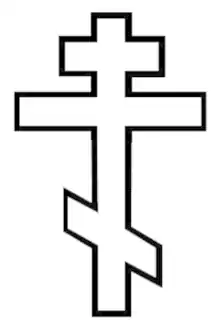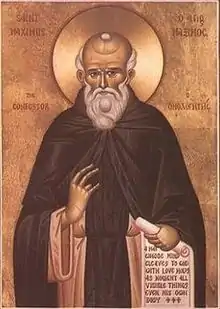January 8 (Eastern Orthodox liturgics)
January 7 - Eastern Orthodox liturgical calendar - January 9
All fixed commemorations below are observed on January 21 by Eastern Orthodox Churches on the Old Calendar.[note 1]
For January 8th, Orthodox Churches on the Old Calendar commemorate the Saints listed on December 26.
Feasts
- Afterfeast of the Theophany of Our Lord and Savior Jesus Christ.[1]
Saints
- Prophet Shemaiah (10th century BC)[2]
- Martyr Julian, his wife Basilissa, and with them Martyrs Celsius, his mother Marcianilla, Anastasius, the priest Anthony, seven brothers, and twenty prison guards, of Antinoe in Egypt (283-305)[1][3]
- Hieromartyr Carterius of Caesarea in Cappadocia (304)[1][4][note 2]
- Saint Elias the Wonderworker, of Egypt (4th century)[1][6] (See also: January 12 - Greek)
- Hieromartyr Theophilus the Deacon, and Martyr Helladius, in Libya (4th century)[1][7][note 3]
- Saint Atticus of Constantinople, Patriarch (425)[1][9]
- Saint Domnica the Righteous of Constantinople (c. 474)[1][10]
- Venerable Agathon of Egypt, monk (5th century)[1][11]
- Venerable Theodore of Constantinople, founder and abbot of the Monastery of Chora (c. 595)[1][12][note 4]
- Venerable George the Chozebite, Abbot (7th century)[1][13][14]
- Saint Cyrus of Constantinople, Patriarch (714)[1][15]
- Martyr Abo of Tiflis, the Perfumer, of Baghdad, at Tbilisi, Georgia (786)[1][16][17]
- Saint Emilian the Confessor, Bishop of Cyzicus (820)[1][6] (See also August 8 - Greek)
- Saint Gregory of Ochrid, Bishop of Moesia (1012)[1][18][note 5]
Pre-Schism Western saints
- Saint Patiens, venerated as the fourth Bishop of Metz and patron-saint of that city (2nd century)[20]
- Hieromartyr Lucian (priest, the "Apostle of Beauvais"), and martyrs Maximian and Julian, in Beauvais in the north of France (290)[20][note 6]
- Saint Eugenian of Autun (Egemoine), Bishop of Autun, a staunch defender of Orthodoxy against Arianism, for which he was martyred (4th century) [20]
- Saint Severinus of Noricum, monk of Göttweig Abbey (Austria and Bavaria) (482)[1][20][21][note 7]
- Saint Ergnad (Ercnacta), born in Ulster in Ireland, she was made a nun by St Patrick (5th century)[20]
- Saint Maximus of Pavia, Bishop of Pavia in Italy, he attended Councils in Rome under Pope Symmachus (511)[20]
- Saint Frodobert, a monk at Luxeuil in France, he founded the monastery of Moutier-la-Celle near Troyes, where he led a life of unceasing prayer and asceticism (673)[20]
- Saint Erhard of Regensburg, Bishop of Regensburg (Bavaria) (c. 686)[1][20]
- Saint Albert of Cashel, English laborer in Ireland and Bavaria (7th century)[20][note 8]
- Holy Virgin Gudula (Goule), patroness of Brussels in Belgium (712)[1][20][note 9]
- Saint Pega, an anchoress in the ancient Anglo-Saxon kingdom of Mercia, and the sister of Saint Guthlac (719)[20][note 10]
- Saint Garibaldus (Gaubald), first Bishop of Regensburg (762)[20][note 11]
- Saint Æthelhelm (Athelm), the first Bishop of Wells, and later Archbishop of Canterbury (926)[20][note 12]
- Saint Wulfsige III (Wulsin), a monk whom St Dunstan loved as a son, became Abbot of Westminster in 980, and Bishop of Sherborne in 993 (1002)[20]
Post-Schism Orthodox saints
- Venerable Gregory, Wonderworker of the Kiev Caves (1093)[1][22]
- Venerable Gregory the Hermit of the Kiev Caves (14th century)[1][23]
- Venerable Macarius (Makris) of Vatopedi on Mt. Athos and Pantocratoros monastery in Constantinople, Abbot (1430)[1][24]
- Hieromartyr Priest Isidore and 72 companions at Yuriev (Dorpats) in Estonia, slain by German Catholic Latins in (1472)[1][25][note 13]
- Saint Paisius of Uglich, Igumen of the Protection monastery, near Uglich (1504)[1][27]
- Venerable Elder Isaiah of Valaam Monastery (1914)[1][28][note 14]
Icon gallery
.jpg.webp) St. Domnica of Constantinople (Menologion of Basil II, 10th century)
St. Domnica of Constantinople (Menologion of Basil II, 10th century)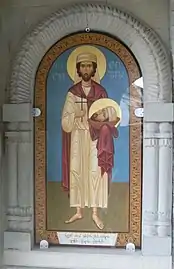 Martyr Abo of Tiflis.
Martyr Abo of Tiflis.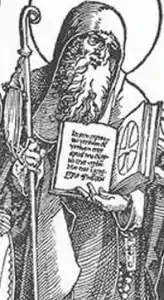 Saint Severinus of Noricum (by Albrecht Dürer).
Saint Severinus of Noricum (by Albrecht Dürer).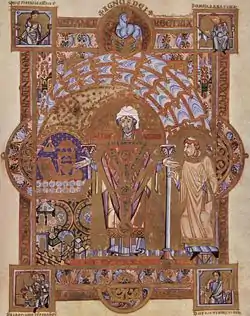 Saint Erhard of Regensburg (Uta-Codex, 11th century).
Saint Erhard of Regensburg (Uta-Codex, 11th century).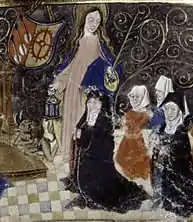 Saint Gudula, patroness of Brussels in Belgium (St. Gudula holds a lantern which a demon endeavors to extinguish).
Saint Gudula, patroness of Brussels in Belgium (St. Gudula holds a lantern which a demon endeavors to extinguish).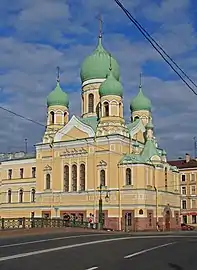 St. Isidore of Yuriev Church, in St. Petersburg.
St. Isidore of Yuriev Church, in St. Petersburg.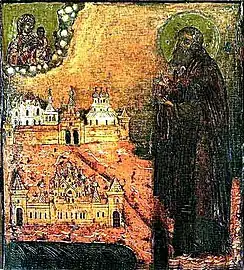 Saint Paisius of Uglich.
Saint Paisius of Uglich.
Notes
- The notation Old Style or (OS) is sometimes used to indicate a date in the Julian Calendar (which is used by churches on the "Old Calendar").
The notation New Style or (NS), indicates a date in the Revised Julian calendar (which is used by churches on the "New Calendar"). - Saint Carterius lived during the reign of Diocletian, and was a teacher in Caesarea of Cappadocia. He stood before a statue of Serapis and prayed to Christ, and the idol shattered to pieces. The procurator Urbanus ordered St Carterius to be tortured and then beheaded. Some, however, say he was killed with a spear.[5]
- "In Lybia [sic], the holy martyrs Theophilus, deacon, and Helladius, who, after being lacerated and cut with sharp pieces of earthenware, were cast into the fire, and rendered their souls to God."[8]
- Around 529 AD, accompanied by two students, Theoplastos and Timothy, he went to Jerusalem in order to worship at the Holy Sepulchre. Returning to Constantinople he built the Monastery of Chora, with two chapels dedicated to Saint Anthimos of Nicomedia and the Holy Forty Martyrs of Sebastia.
- Saint Gregory was a faithful teacher and shepherd of Christ’s flock. An inscription in the church of Holy Wisdom (Hagia Sophia) in Ochrid refers to him as “Gregory the Wise.”[19]
- "At Beauvais, in France, the holy martyrs Lucian, priest, Maximian and Julian. The last two were killed with the sword by the persecutors; but blessed Lucian, who had come to France with St. Denis, not fearing, after the slaughter of his companions, to confess the name of Christ openly, received the same sentence of death."[8]
- An Eastern monk who enlightened Noricum Ripensis, now in Austria. He founded several monasteries, notably one on the Danube near Vienna, where he organised help for those afflicted by the invasions of Attila and the Huns and where he reposed. Six years after his repose, the monks were driven out and took his relics to Naples in Italy, where the monastery of San Severino was built to enshrine them.
- Patron-saint of Cashel in Ireland. According to some, he had been born in England, laboured in Ireland and later preached in Bavaria. He then went to Jerusalem and on his return reposed and was buried in Regensburg.
- Daughter of St Amelberga, she spent much time with St Gertrude at Nivelles and afterwards lived a life of holiness.
- The sister of St Guthlac of Crowland in England. She too lived as an anchoress. The village of Peakirk (Pega's church) in Northamptonshire is called after her.
- He was consecrated by St Boniface in c. 740. He had probably been Abbot of St Emmeran in Regensburg before this.
- Paternal uncle of St Dunstan. A monk and then Abbot of Glastonbury in England, he became first Bishop of Wells in Somerset and in 923 twenty-first Archbishop of Canterbury.
- The Priest-Martyr Isidor was priest of the Nikol'sk church in the city of Yur'ev (Derpto, at present Taru in Estonia). According to the terms of a treaty concluded in 1463 between the Moscow Great Prince Ivan III and the Livonian Knights, the latter were obligated to extend very protection to the Orthodox at Derpto. But the Livonian knights broke the treaty and began to try forcing the Orthodox into the Unia. Presbyter Isidor bravely stood forth in defense of Orthodoxy. He preferred to accept a martyr's crown rather than submit to the Catholics. Blessed Isidor together with 72 of his parishioners were drowned in the ice-hole, cut open on the feast of Theophany after the blessing of waters in the River Amovzha (or Emaiyga, now Emajogi). In Spring, during a time of flooding, the undecayed bodies of the holy martyrs, and among them the fully vested body of the Priest-Martyr Isidor, were found by Russian merchants journeying along the River bank. They buried the saints around the Nikol'sk church.[26]
- One writer (Nemirovich-Danchenko), having visited Valaam, called it the kingdom of muzhiks, pointing to the peasant make-up of its monks. But in actuality he hinted at the holy aspect of the simple Russian peasantry that filled many monasteries with men of God. Such was the unsophisticated ascetic Father Isaiah, hidden from the eye of the world as a simpleton, but in actuality a saint. He went through the usual severe Valaam basic training and, when ripe to be molded by God, he secluded himself in a remote skete cell to face his Master. He never washed the smoke from the stove off his cell walls, he covered his windows so that his cell felt like a cave or a grave. There, in the silence of his dark cell, he became a partaker of noetic mysticism. But he was observable to us only in his severe self-denial, as he endured cold, hunger and pain. It was discovered after his death that his toenails had grown into his boots, a condition which he had endured as an act of asceticism. This was not a deliberate self-mortification, but the result of a man's total preoccupation with visions from above (theona) to the neglect of "all below ".[29]
References
- January 8/January 21. Orthodox Calendar (PRAVOSLAVIE.RU).
- Great Synaxaristes: (in Greek) Ὁ Προφήτης Σαμέας. 8 Ιανουαρίου. ΜΕΓΑΣ ΣΥΝΑΞΑΡΙΣΤΗΣ.
- Great Synaxaristes: (in Greek) Οἱ Ἅγιοι Ἰουλιανός, Βασίλισσα, Κέλσιος, Ἀναστάσιος καὶ Ἀντώνιος οἱ Μάρτυρες. 8 Ιανουαρίου. ΜΕΓΑΣ ΣΥΝΑΞΑΡΙΣΤΗΣ.
- Great Synaxaristes: (in Greek) Ὁ Ἅγιος Καρτέριος ὁ Ἱερομάρτυρας. 8 Ιανουαρίου. ΜΕΓΑΣ ΣΥΝΑΞΑΡΙΣΤΗΣ.
- St Carterius of Caesarea in Cappadocia. OCA - Lives of the Saints.
- The Autonomous Orthodox Metropolia of Western Europe and the Americas (ROCOR). St. Hilarion Calendar of Saints for the year of our Lord 2004. St. Hilarion Press (Austin, TX). p.6.
- Great Synaxaristes: (in Greek) Οἱ Ἅγιοι Θεόφιλος καὶ Ἑλλάδιος οἱ Μάρτυρες. 8 Ιανουαρίου. ΜΕΓΑΣ ΣΥΝΑΞΑΡΙΣΤΗΣ.
- The Roman Martyrology. Transl. by the Archbishop of Baltimore. Last Edition, According to the Copy Printed at Rome in 1914. Revised Edition, with the Imprimatur of His Eminence Cardinal Gibbons. Baltimore: John Murphy Company, 1916. pp.8-9.
- Great Synaxaristes: (in Greek) Ὁ Ἅγιος Ἀττικὸς Πατριάρχης Κωνσταντινουπόλεως. 8 Ιανουαρίου. ΜΕΓΑΣ ΣΥΝΑΞΑΡΙΣΤΗΣ.
- Great Synaxaristes: (in Greek) Ἡ Ὁσία Δομνίκη. 8 Ιανουαρίου. ΜΕΓΑΣ ΣΥΝΑΞΑΡΙΣΤΗΣ.
- Great Synaxaristes: (in Greek) Ὁ Ὅσιος Ἀγάθων. 8 Ιανουαρίου. ΜΕΓΑΣ ΣΥΝΑΞΑΡΙΣΤΗΣ.
- Great Synaxaristes: (in Greek) Ὁ Ὅσιος Θεόδωρος Κτήτορας καὶ Ἡγούμενος τῆς μονῆς τῆς Χώρας. 8 Ιανουαρίου. ΜΕΓΑΣ ΣΥΝΑΞΑΡΙΣΤΗΣ.
- Great Synaxaristes: (in Greek) Ὁ Ὅσιος Γεώργιος ὁ Χοζεβίτης. 8 Ιανουαρίου. ΜΕΓΑΣ ΣΥΝΑΞΑΡΙΣΤΗΣ.
- THE FEAST OF SAINTS IOANNIS AND GEORGIOS THE CHOSEBITES. Jerusalem Patriarchate: Official News Gate. 21/01/2017. Retrieved: 23 January 2017.
- Great Synaxaristes: (in Greek) Ὁ Ἅγιος Κύρος Ἀρχιεπίσκοπος Κωνσταντινουπόλεως. 8 Ιανουαρίου. ΜΕΓΑΣ ΣΥΝΑΞΑΡΙΣΤΗΣ.
- Great Synaxaristes: (in Greek) Ὁ Ἅγιος Ἀβὼ ὁ Μάρτυρας. 8 Ιανουαρίου. ΜΕΓΑΣ ΣΥΝΑΞΑΡΙΣΤΗΣ.
- Martyr Abo the Perfumer, of Tibilisi, Georgia. OCA - Lives of the Saints.
- Great Synaxaristes: (in Greek) Ὁ Ἅγιος Γρηγόριος Ἐπίσκοπος Μοισίας. 8 Ιανουαρίου. ΜΕΓΑΣ ΣΥΝΑΞΑΡΙΣΤΗΣ.
- Venerable Gregory of Ochrid. OCA - Lives and Saints.
- January 8. Latin Saints of the Orthodox Patriarchate of Rome.
- Great Synaxaristes: (in Greek) Ὁ Ἅγιος Σεβερίνος. 8 Ιανουαρίου. ΜΕΓΑΣ ΣΥΝΑΞΑΡΙΣΤΗΣ.
- Great Synaxaristes: (in Greek) Ὁ Ἅγιος Γρηγόριος ὁ Ὁσιομάρτυρας καὶ Θαυματουργός. 8 Ιανουαρίου. ΜΕΓΑΣ ΣΥΝΑΞΑΡΙΣΤΗΣ.
- Great Synaxaristes: (in Greek) Ὁ Ὅσιος Γρηγόριος ὁ Ἔγκλειστος. 8 Ιανουαρίου. ΜΕΓΑΣ ΣΥΝΑΞΑΡΙΣΤΗΣ.
- Great Synaxaristes: (in Greek) Ὁ Ὅσιος Μακάριος Μακρής. 8 Ιανουαρίου. ΜΕΓΑΣ ΣΥΝΑΞΑΡΙΣΤΗΣ.
- Great Synaxaristes: (in Greek) Ὁ Ἅγιος Ἰσίδωρος ὁ Ἱερομάρτυρας καὶ οἱ σὺν αὐτῶ 72 Μάρτυρες. 8 Ιανουαρίου. ΜΕΓΑΣ ΣΥΝΑΞΑΡΙΣΤΗΣ.
- The PriestMartyr Isidor. HOLY TRINITY RUSSIAN ORTHODOX CHURCH (A parish of the Patriarchate of Moscow).
- Great Synaxaristes: (in Greek) Ὁ Ὅσιος Παΐσιος ἐκ Ρωσίας. 8 Ιανουαρίου. ΜΕΓΑΣ ΣΥΝΑΞΑΡΙΣΤΗΣ.
- Great Synaxaristes: (in Greek) Ὁ Ὅσιος Ἡσαΐας. 8 Ιανουαρίου. ΜΕΓΑΣ ΣΥΝΑΞΑΡΙΣΤΗΣ.
- Anchorite Isaiah (1831-1914). VALAAM PATERICON. Retrieved 2013-02-23.
- January 21 / January 8. HOLY TRINITY RUSSIAN ORTHODOX CHURCH (A parish of the Patriarchate of Moscow).
- (in Russian) 8 января (ст.ст.) 21 января 2013 (нов. ст.). Русская Православная Церковь Отдел внешних церковных связей. (DECR).
Sources
- January 8/January 21. Orthodox Calendar (PRAVOSLAVIE.RU).
- January 21 / January 8. HOLY TRINITY RUSSIAN ORTHODOX CHURCH (A parish of the Patriarchate of Moscow).
- January 8. OCA - The Lives of the Saints.
- The Autonomous Orthodox Metropolia of Western Europe and the Americas (ROCOR). St. Hilarion Calendar of Saints for the year of our Lord 2004. St. Hilarion Press (Austin, TX). p. 6.
- January 8. Latin Saints of the Orthodox Patriarchate of Rome.
- The Roman Martyrology. Transl. by the Archbishop of Baltimore. Last Edition, According to the Copy Printed at Rome in 1914. Revised Edition, with the Imprimatur of His Eminence Cardinal Gibbons. Baltimore: John Murphy Company, 1916. pp. 8–9.
Greek Sources
- Great Synaxaristes: (in Greek) 8 ΙΑΝΟΥΑΡΙΟΥ. ΜΕΓΑΣ ΣΥΝΑΞΑΡΙΣΤΗΣ.
- (in Greek) Συναξαριστής. 8 Ιανουαρίου. ECCLESIA.GR. (H ΕΚΚΛΗΣΙΑ ΤΗΣ ΕΛΛΑΔΟΣ).
Russian Sources
- (in Russian) 21 января (8 января). Православная Энциклопедия под редакцией Патриарха Московского и всея Руси Кирилла (электронная версия). (Orthodox Encyclopedia - Pravenc.ru).
- (in Russian) 8 января (ст.ст.) 21 января 2013 (нов. ст.). Русская Православная Церковь Отдел внешних церковных связей. (DECR).
This article is issued from Wikipedia. The text is licensed under Creative Commons - Attribution - Sharealike. Additional terms may apply for the media files.
